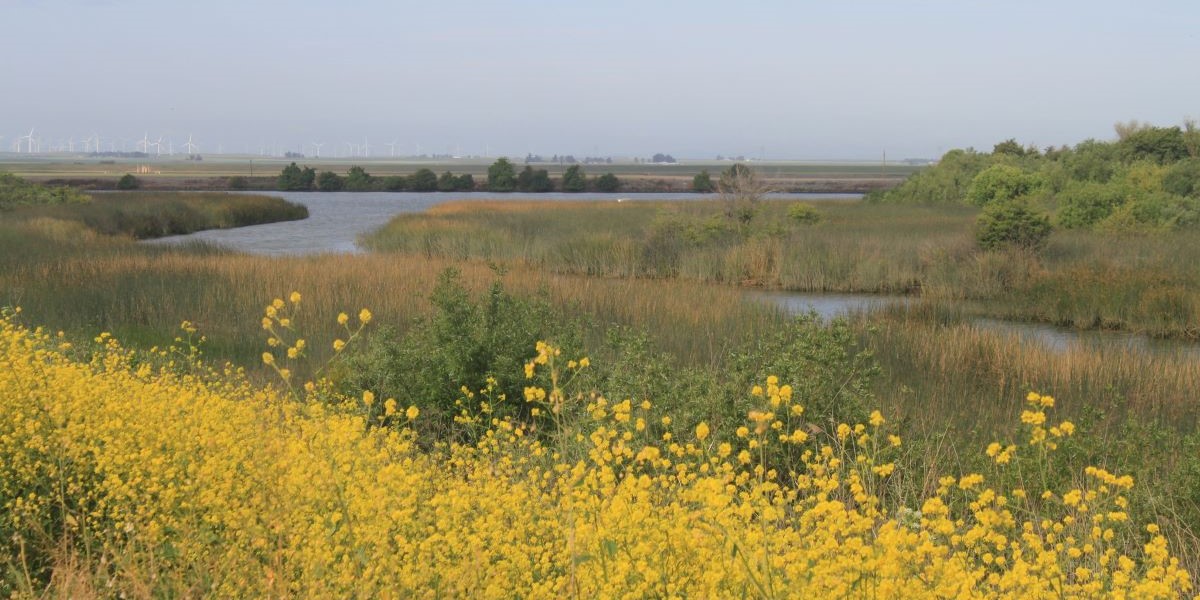On May 5 of 2022, the Delta Science Program hosted the third and final session of a webinar series focusing on governance in the Sacramento-San Joaquin Delta. The goal of the series was to shed light on the social, political, and institutional dimensions of Delta science and management and to consider how those institutional structures and processes support effective and equitable environmental management in the Delta.
Participating in this webinar:
- Dr. Tanya Heikkila is a professor at the School of Public Affairs at the University of Colorado Denver, where she also co-directs the Center for Policy and Democracy. Since 2020, she’s also served as a member of the Delta Independent Science Board. Her research and teaching focus on policy processes and environmental governance.
- Dr. Newsha Ajami is the chief research strategy and development officer for the Earth and Environmental Sciences at Lawrence Berkeley National Lab and a leading expert in sustainable water resource management, smart cities, and the water energy food nexus. Dr. Ajami uses data science principles to study the human and policy dimensions of urban water and hydrologic systems.
- Harriet Lai Ross is the assistant planning director at the Delta Stewardship Council, where she manages the Council’s comprehensive climate change study, Delta Adapts. Harriet’s background is in land use and environmental planning, addressing issues throughout California related to developing sustainable communities, building climate resilience, conserving natural resources, and inclusive community engagement.
- Dr. Hannah Gosnell is a Professor of Geography at Oregon State University, where she studies biodiversity conservation, water resource management, climate change, and environmental governance in the context of rural working landscapes in the US West. Her research addresses the human dimensions of natural resource management from the social-ecological systems perspective and has focused in part on the emergence, evolution, and devolution of collaborative adaptive governance in the Klamath Basin.
QUESTION: What is adaptive governance?
Since each speaker has a unique perspective, each panelist began by answering this question.
Dr. Tanya Heikkila
Adaptive governance involves governance systems that are adaptive and comprised of the actors, organizations, processes, policies, and laws that shape collective decisions and the governance of social-ecological systems. Governance can occur across multiple scales of authority and issues, but to be adaptive, these systems must have the capacity to respond to changing conditions, often under uncertainty, and typically to build resilience in social-ecological systems.
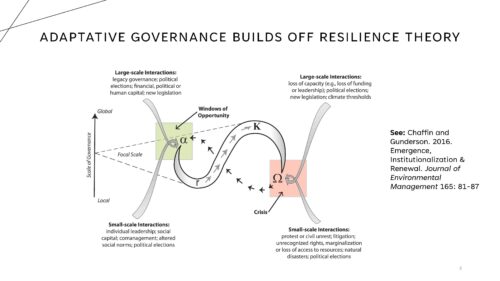 The concept of adaptive governance builds off of resilience theory. In applying this concept to adaptive governance, Chaffin and Gunderson note that the role of episodic disturbances or these changes or crises to a governance system can happen across scales and trigger reorganizations in governance. These may sometimes be thought of as periods of collapse or rebirth in governance towards forms that have increased capacity to function amidst complexity and uncertainty.
The concept of adaptive governance builds off of resilience theory. In applying this concept to adaptive governance, Chaffin and Gunderson note that the role of episodic disturbances or these changes or crises to a governance system can happen across scales and trigger reorganizations in governance. These may sometimes be thought of as periods of collapse or rebirth in governance towards forms that have increased capacity to function amidst complexity and uncertainty.
Without digging into the details of the theory, Dr. Heikkila noted the takeaway is the assumption underlying adaptive governance is the potential for the system to be resilient in the face of disturbances.
As for the relationship between adaptive management and adaptive governance, adaptive governance creates the structure and the capacity within which adaptive management of specific programs or actions can be implemented. However, she noted that the adaptive management process of experimentation, monitoring, and evaluation can also identify where and when changes in governance are needed.
“So they interrelate, and both emphasize processes of intentional learning,” said Dr. Heikkila.
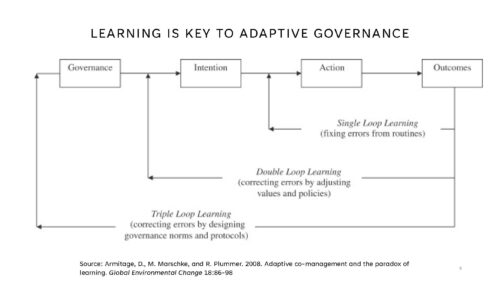 “Learning in adaptive governance isn’t just about technical learning, or learning from scientific data and monitoring and management of policy actions, as we might think of in this concept of single loop learning where we might be fixing errors we’re observing in our management routines,” she said. “It’s often about some deeper forms of learning, which might include learning about values and goals of policies and adjusting those values, or even fundamental restructuring of the norms underlying our governance system, thought of as triple loop learning, that could be changing who’s allowed to engage in governance.”
“Learning in adaptive governance isn’t just about technical learning, or learning from scientific data and monitoring and management of policy actions, as we might think of in this concept of single loop learning where we might be fixing errors we’re observing in our management routines,” she said. “It’s often about some deeper forms of learning, which might include learning about values and goals of policies and adjusting those values, or even fundamental restructuring of the norms underlying our governance system, thought of as triple loop learning, that could be changing who’s allowed to engage in governance.”
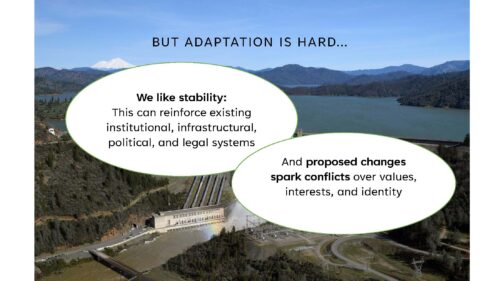 Dr. Heikkila pointed out that learning and adaptation are not necessarily automatic; they’re often hard, especially in complex systems.
Dr. Heikkila pointed out that learning and adaptation are not necessarily automatic; they’re often hard, especially in complex systems.
“The image of Shasta Dam illustrates our tendency to build systems for stability and reliability. When we build these systems, they can become path-dependent; the infrastructure is very hard to change. The institutions, political, and legal systems devised to support and maintain them also become hard to change. And when changes or adaptation is proposed, that can spur conflicts over the values, interests, and identities of the people involved, especially if they feel that their pre-existing positions are threatened. And this can further slow the pace of change.”
So given these challenges, Dr. Heikkila highlighted key lessons from the academic literature about what supports adaptive governance.
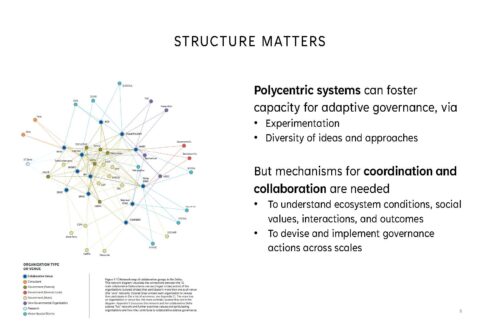 Structure matters. Polycentric systems have overlapping centers of authority. They are known from empirical and theoretical research to foster the capacity for adaptive governance because they can allow for experimentation and diversity of ideas and approaches. But they require effective mechanisms for coordination and collaboration. The image on the slide represents the polycentric nature of the Delta science enterprise, with the multiple organizations and diverse venues where science decision-making happens in the Delta. “It’s just one slice of the Delta governance system,” she said. “And while some people might worry that such a complex system looks like chaos, these systems can support adaptive governance if coordination and collaboration are designed effectively.”
Structure matters. Polycentric systems have overlapping centers of authority. They are known from empirical and theoretical research to foster the capacity for adaptive governance because they can allow for experimentation and diversity of ideas and approaches. But they require effective mechanisms for coordination and collaboration. The image on the slide represents the polycentric nature of the Delta science enterprise, with the multiple organizations and diverse venues where science decision-making happens in the Delta. “It’s just one slice of the Delta governance system,” she said. “And while some people might worry that such a complex system looks like chaos, these systems can support adaptive governance if coordination and collaboration are designed effectively.”
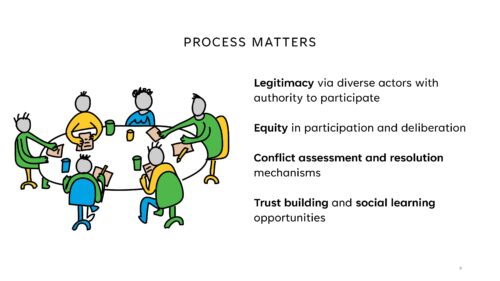 Process matters: Good governance processes generally are even more important for adaptive governance, largely because those need processes that support learning and experimentation and diversity of knowledge and ideas. “So we need things like diverse actors who have legitimacy and equity in participation, and we need to be able to diagnose and resolve conflicts, particularly build trust and social learning,” she said.
Process matters: Good governance processes generally are even more important for adaptive governance, largely because those need processes that support learning and experimentation and diversity of knowledge and ideas. “So we need things like diverse actors who have legitimacy and equity in participation, and we need to be able to diagnose and resolve conflicts, particularly build trust and social learning,” she said.
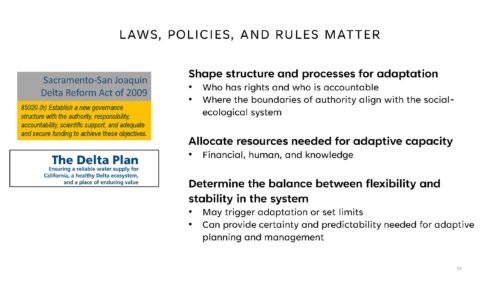 Laws, policies, and rules matter: The laws, policies, and rules matter for shaping the structure and the processes of adaptive governance, such as who has rights in decision-making and the boundaries of those decisions. These rules also allocate the resources needed for adaptive capacity and determine the required balance between flexibility and stability. For example, Dr. Heikkila noted that the Delta Reform Act of 2009 provides laws that structure the capacity for adaptive governance in the Delta. It emerged in response to the unraveling of the Cal Fed process. It set up new standards for who has authority, where the boundaries of that authority lie, and created organizational and financial resources, such as the Delta Stewardship Council and other agencies, to set up the framework for requiring a plan that’s regularly reviewed scientifically and updated.
Laws, policies, and rules matter: The laws, policies, and rules matter for shaping the structure and the processes of adaptive governance, such as who has rights in decision-making and the boundaries of those decisions. These rules also allocate the resources needed for adaptive capacity and determine the required balance between flexibility and stability. For example, Dr. Heikkila noted that the Delta Reform Act of 2009 provides laws that structure the capacity for adaptive governance in the Delta. It emerged in response to the unraveling of the Cal Fed process. It set up new standards for who has authority, where the boundaries of that authority lie, and created organizational and financial resources, such as the Delta Stewardship Council and other agencies, to set up the framework for requiring a plan that’s regularly reviewed scientifically and updated.
“Of course, that framework may not be perfect, and one may question whether it’s achieving the goals of resilience that underlies adaptive governance, and the approach taken for implementation has been challenged,” she said. “But recent court decisions, for example, have recognized and acknowledged that the stability of that system can continue and help reinforce the adaptive approach to continue.”
Dr. Newsha Ajami
Dr. Ajami began by noting that she is an engineer by training and that engineers and decision-makers are grappling with how we can rethink our governance and management structure to build climate resilience.
“We live in a world defined by 19th-century laws and 20th-century infrastructure; however, we face 21st-century water and environmental challenges,” said Dr. AJami. “The reality is neither 19th-century laws nor the 20th-century infrastructure are able or capable to respond to some of these challenges.”
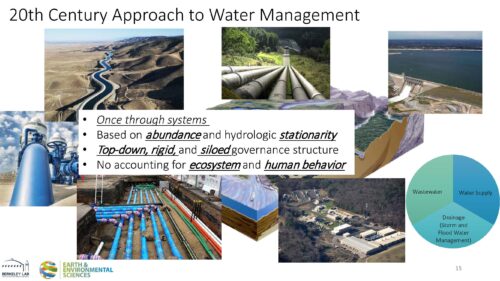 The 20th-century approach to water management was very much infrastructure-heavy and siloed. Centralized systems were built into watersheds to create water reliability and security. We assumed we could create abundance, and we assumed hydrologic stationarity, meaning that climate and hydrology would repeat itself over and over, so we could manage the system without necessarily thinking about uncertainty and flexibility.
The 20th-century approach to water management was very much infrastructure-heavy and siloed. Centralized systems were built into watersheds to create water reliability and security. We assumed we could create abundance, and we assumed hydrologic stationarity, meaning that climate and hydrology would repeat itself over and over, so we could manage the system without necessarily thinking about uncertainty and flexibility.
“We created very top-down and rigid and siloed governance structures that would enable this management,” said Dr. Ajami. “But the one thing that we didn’t do was incorporate the ecosystem and human behavior as part of this process, which in the 21st-century challenges we are facing, is a big challenge.”
This has worked for the last 50 to 100 years, but challenges and their impacts, such as climate change, floods, fires, and droughts – are manifesting through water systems and the water cycle, and this fragmented system isn’t really working anymore.
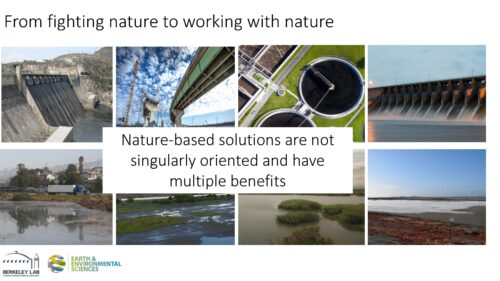 “We are realizing that we have to work with nature if we want to deal with our 21st-century challenges,” said Dr. Ajami. “In the 21st century, we need to be thinking about the Delta as living natural infrastructure. We need to think about marshlands and other natural systems that play a major role in enabling us to fight climate change or create an opportunity for us to deal with some of the consequences of climate change that we are facing. And the challenge is, how do you put these two pieces in the top and bottom rows together? How do you manage them together? How do you ensure you can fund and actually govern them?”
“We are realizing that we have to work with nature if we want to deal with our 21st-century challenges,” said Dr. Ajami. “In the 21st century, we need to be thinking about the Delta as living natural infrastructure. We need to think about marshlands and other natural systems that play a major role in enabling us to fight climate change or create an opportunity for us to deal with some of the consequences of climate change that we are facing. And the challenge is, how do you put these two pieces in the top and bottom rows together? How do you manage them together? How do you ensure you can fund and actually govern them?”
Conventional infrastructure, such as a dam, is more singularly oriented and designed to do specific things that can easily be measured: water, electricity, or flood management capability. But nature-based solutions have broad and multiple benefits that can be hard to quantify.
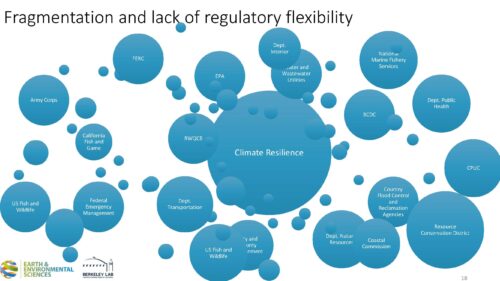 “When it comes to permitting or building these kinds of infrastructure when thinking about the fragmentation that we have created, it makes it very difficult for us to build climate resiliency,” said Dr. Ajami. “Because if we want to build a horizontal levee or other nature-based infrastructure, we have to go through so many different loops and hoops, get different permits, meet different requirements, and meet different performance measures. And often, the conventional infrastructure path is easier. It’s faster; however, when it comes to these nature-based solutions, it’s much more complex and harder to fund them.”
“When it comes to permitting or building these kinds of infrastructure when thinking about the fragmentation that we have created, it makes it very difficult for us to build climate resiliency,” said Dr. Ajami. “Because if we want to build a horizontal levee or other nature-based infrastructure, we have to go through so many different loops and hoops, get different permits, meet different requirements, and meet different performance measures. And often, the conventional infrastructure path is easier. It’s faster; however, when it comes to these nature-based solutions, it’s much more complex and harder to fund them.”
Regulatory rigidity presents another challenge. What is infrastructure, and how do we define it? Should it be broadly defined, such as the Delta or wetlands, or is it limited to just gray infrastructure? How do we measure the performance of nature-based infrastructure compared to conventional infrastructure? How will we finance this? Who is involved and why? What agencies are involved in permitting, and what is at stake for each of them? How do we create flexibility around that? How do we measure performance across these agency and regulatory bodies to be able to permit solutions that are important for us to become climate resilient but doesn’t singularly serve one single purpose? And then, which governing or management bodies should pay for these kinds of infrastructure designs?
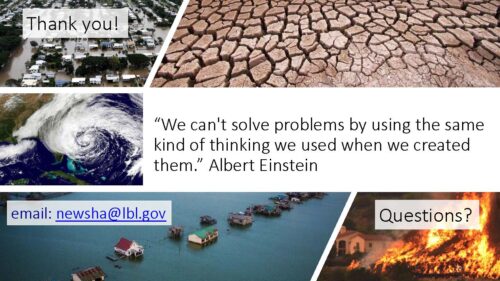 “These are the questions I think about with adaptive governance; I think about how we need to revise and repurpose and rethink our governance structure and how we need to move toward adaptive governance,” said Dr. Ajami. “I will close with the quote, ‘we can’t solve problems by using the same kind of thinking we used when we created them.’ And that is exactly the time and stage we are in because we are trying to fit our current solutions into our old and conventional governance structure. And it’s just clashing in so many different ways. So adaptive governance is key in this transition.”
“These are the questions I think about with adaptive governance; I think about how we need to revise and repurpose and rethink our governance structure and how we need to move toward adaptive governance,” said Dr. Ajami. “I will close with the quote, ‘we can’t solve problems by using the same kind of thinking we used when we created them.’ And that is exactly the time and stage we are in because we are trying to fit our current solutions into our old and conventional governance structure. And it’s just clashing in so many different ways. So adaptive governance is key in this transition.”
Harriet Lai Ross
Ms. Ross framed her comments around the need for adaptive governance in the Delta through the lens of the Council’s climate change study, Delta Adapts, and how the governance system really needs to change to allow for more effective adaptation.
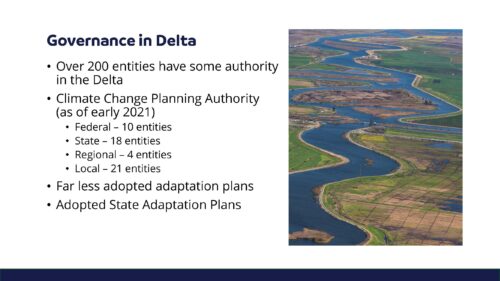 Currently, climate adaptation is primarily being implemented at the local level because local governments have land use authority to approve projects, or broadly at the state level, where the goal is to protect the state’s interests.
Currently, climate adaptation is primarily being implemented at the local level because local governments have land use authority to approve projects, or broadly at the state level, where the goal is to protect the state’s interests.
“I think adaptation needs to be implemented at a regional scale to be more effective, said Ms. Lai Ross. “There are currently over 200 different entities with some authority in the Delta, which makes working here so interesting. There are, however, far fewer entities in the Delta with some authority for climate change planning at the federal, state, regional, and local levels. Still, there’s a lot of different entities to coordinate implementation within a region and a lot of fragmentation.”
“There are even far fewer of these entities with adopted adaptation policies. So there are a lot of vulnerability assessments out there but not a lot of adaptation plans. And this really highlights how difficult adaptation can be.”
Ms. Lai Ross acknowledged that the state has adopted several adaptation plans recently. Still, they tend to be high-level guiding documents, aren’t regulations, and focus on the entity’s assets rather than all in a particular geographic area. So climate change planning tends to be fragmented and not comprehensive.
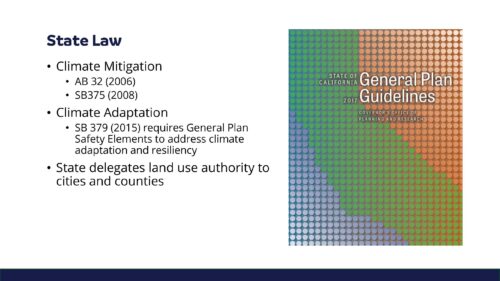 In 2015, the legislature passed SB 379, which required local governments to address climate adaptation and resiliency in their general plans. However, since land use authority rests with the cities and counties, it can be difficult to implement adaptation projects on a regional scale when the ability to approve projects rests primarily at the local level.
In 2015, the legislature passed SB 379, which required local governments to address climate adaptation and resiliency in their general plans. However, since land use authority rests with the cities and counties, it can be difficult to implement adaptation projects on a regional scale when the ability to approve projects rests primarily at the local level.
Project planning, permitting, implementation, and funding in the Delta can rest with different entities. “This is where the struggle between the state and local governments can come to light. Local entities don’t want the state to come in and mandate action,” said Ms. Lai Ross. “Meanwhile, the state is trying to protect its interests for the greater good of the state and its residents without local land use authority.”
“It’s important to note that the state can do what they want on the land they own – they can build projects, and that happens all the time. But the state doesn’t have to comply with local regulations, which furthers the conflict.”
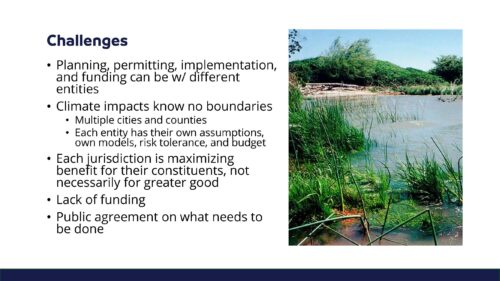 Another challenge is that climate actions don’t stop at jurisdictional boundaries, and often solutions need to be implemented for a much larger geographic area. Also, different entities tend to have their own assumptions for assessing climate vulnerabilities; they may have models they want to use to forecast impacts, which can yield different results for neighboring jurisdictions. Each entity also has its own political agenda and its own tolerance for risk, so it can be difficult to agree on strategies to address impacts. Finally, each jurisdiction has its own budget to address climate vulnerabilities, and often there can be a mismatch of funding to address adaptation compared to the impact a location is experiencing.
Another challenge is that climate actions don’t stop at jurisdictional boundaries, and often solutions need to be implemented for a much larger geographic area. Also, different entities tend to have their own assumptions for assessing climate vulnerabilities; they may have models they want to use to forecast impacts, which can yield different results for neighboring jurisdictions. Each entity also has its own political agenda and its own tolerance for risk, so it can be difficult to agree on strategies to address impacts. Finally, each jurisdiction has its own budget to address climate vulnerabilities, and often there can be a mismatch of funding to address adaptation compared to the impact a location is experiencing.
“Each jurisdiction is trying to maximize the benefit for their own constituents and not necessarily for the greater good because that’s not their charge,” said Ms. Lai Ross. “And local priorities don’t always align. Also, another big challenge is that, in general, there’s just not enough funding to address climate impacts. The Delta is not unique in that; that’s everywhere. The $3.7 billion climate resilience budget passed to the state last year begins to help but won’t pay for everything. And lastly, a big challenge is that not everyone agrees on how to address or adapt to climate change and what needs to be done.”
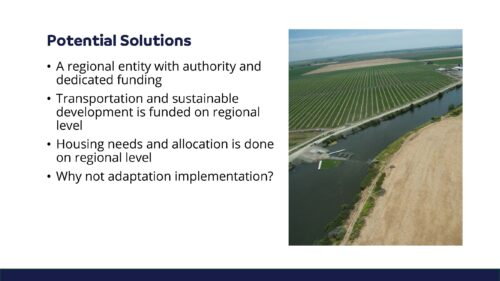 The solution is to approach climate planning and implementation of adaptation at the regional level. This is happening to a certain extent; Delta Adapts is comprehensively planning for climate change for the region; the Bay Conservation and Development Commission is planning for the San Francisco Bay as a whole, and folks in the cities and counties that make up the Silicon Valley have come together and put together their own regional plan. Still, implementation of adaptation is not widely occurring at a regional level because the challenges in planning, permitting, implementation, and funding of projects involve so many entities, and the local governments have land use control.
The solution is to approach climate planning and implementation of adaptation at the regional level. This is happening to a certain extent; Delta Adapts is comprehensively planning for climate change for the region; the Bay Conservation and Development Commission is planning for the San Francisco Bay as a whole, and folks in the cities and counties that make up the Silicon Valley have come together and put together their own regional plan. Still, implementation of adaptation is not widely occurring at a regional level because the challenges in planning, permitting, implementation, and funding of projects involve so many entities, and the local governments have land use control.
“Ideally, if I could wave a magic wand, we’d have a regional entity with authority with teeth, and a dedicated stream of funding to implement adaptation projects that a whole region has provided input and agreed upon that they need,” said Ms. Lai Ross. “But that doesn’t exist here in the Delta, nor in many other regions.”
She pointed out that many important societal issues in the state are addressed regionally, such as transportation, sustainable development, greenhouse gas emission reduction, and housing.
“Regional entities were formed to prepare a regional plan to address these issues and to implement or fund projects consistent with that plan. So why can’t we approach the implementation of the adaptation in that same way?”
She noted that the 2021 climate resilience budget’s legislation and funding are moving toward creating regional collaboratives and regional planning. “It’s not the regional entity with teeth and dedicated funding, but we’re getting closer,” said Ms. Lai Ross.
Dr. Hannah Gosnell
Dr. Gosnell became interested in adaptive governance in the mid-2000s through her work at Oregon State University studying the emergence and evolution of collaborative conservation in the Klamath Basin. For this presentation, she was requested to provide a brief overview of the Klamath Basin and give her insights into the possibilities of adaptive governance, as well as the potential pitfalls.
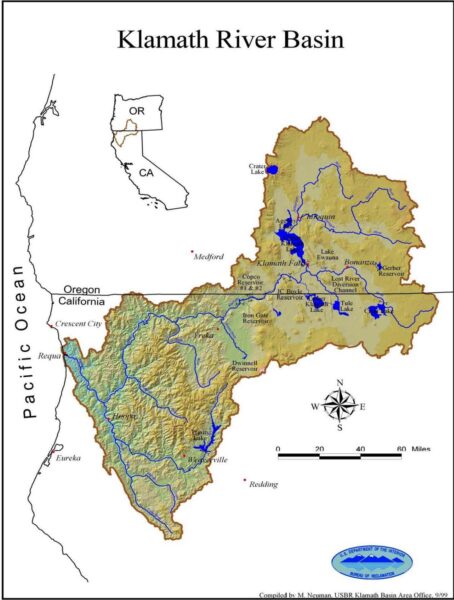 The Klamath Basin is located around the Oregon-California border. It’s a complicated basin as the upper and lower basins are geographically distinct with separate sets of issues. The key feature in the upper basin is Klamath Lake, the largest lake in Oregon. The lake has three main tributaries: the Wood, the Williamson, and the Sprague.
The Klamath Basin is located around the Oregon-California border. It’s a complicated basin as the upper and lower basins are geographically distinct with separate sets of issues. The key feature in the upper basin is Klamath Lake, the largest lake in Oregon. The lake has three main tributaries: the Wood, the Williamson, and the Sprague.
Until the 20th century, wetlands provided a lot of habitat for suckerfish and were an important stopover on the Pacific Flyway. Salmon used to migrate up into the tributaries above Klamath Lake.
The area is now mostly ranching, but importantly, this region has been the Klamath Tribes’ territory for thousands of years.
In the lower basin, there are three other tribes: the Karuk, the Yurok, and Hoopa Valley tribes, who are all salmon fishing people. The lower basin has less agriculture and a more forested landscape with a history of poor management practices. Salmon fishermen on the Oregon coast are also important stakeholders in the lower basin in the current conflict.
The story of the Klamath Basin can be framed in many ways; one way is to look at how federal and state governments have transformed the landscape, largely to accommodate irrigated agriculture with the Bureau of Reclamation’s Klamath project, using 20th-century infrastructure with a conquering mentality. The reclamation of wetlands for agriculture and agricultural practices in the basin have led to problems with habitat loss for several species. In addition, a lot of over-promising of water to diverse interests over time in an incoherent way has led to an intractable mess.
In 1988, two species important to the Klamath Tribes were listed under the Endangered Species Act. Throughout the 1990s, there was growing tension as the Fish and Wildlife Service and the Bureau of Reclamation tried to figure out biological opinions that would leave enough water in the lake for the two listed fish but also allow farmers to continue irrigating and allow enough water to flow downstream for the salmon in the lower basin. Further complicating matters, the coho salmon were listed as threatened in 1997.
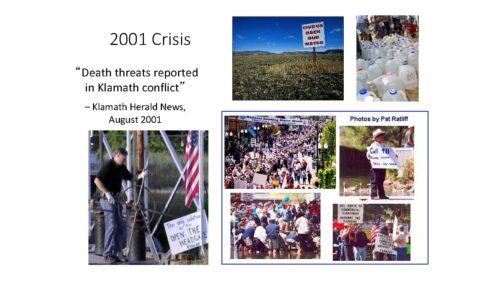 These tensions all came to a head in 2001. The snowpack was at 32%; lake levels were below the levels required for the fish under the ESA. Under Section 7, the Bureau of Reclamation had to consult the Fish and Wildlife Service and the National Marine Fisheries Services regarding the endangered fish.
These tensions all came to a head in 2001. The snowpack was at 32%; lake levels were below the levels required for the fish under the ESA. Under Section 7, the Bureau of Reclamation had to consult the Fish and Wildlife Service and the National Marine Fisheries Services regarding the endangered fish.
“In the Lower Basin, they were trying to balance keeping enough water in the upper basin for the sucker fish in the farmers while releasing enough to the lower basin for the salmon,” said Dr. Gosnell. “This resulted in the Bureau shutting off water to the farmers in the summer of 2001, leaving thousands of acres without irrigation and an estimated $35 million in lost farm income. This, of course, led to outrage in the basin and throughout the West. It made national news, even international news.”
“It became the poster child for the evils of the Endangered Species Act and the federal government generally. Protesters came to town; there were acts of civil disobedience, people tried to open the head gates, and there were death threats. And there were many symbolic acts of support like filling jugs of water and pouring them into irrigation canals.”
In 2006, when Dr. Gosnell began her research, there were signs that stakeholders were starting to come together to solve problems on their own, having lost faith in the ability of the federal government to do it for them. Several innovative grassroots efforts had begun over the FERC dam relicensing process, and those talks scaled up to become whole basin settlement talks.
There were formal monthly meetings between the 28 key basin stakeholders regarding dam removal versus retrofitting the dams for fish passage and hundreds of informal side meetings with other stakeholders facilitated by local and regional groups. Over time, a new goal emerged to address all the major conflicts in one document instead of just the dam issue to include water, power, endangered species, and tribal claims.
In 2007, the process transitioned from a consensus to a coalition. The outcome was the Klamath Basin Restoration Agreement (KBRA) and the Klamath Hydroelectric Settlement Agreement (KHSA), which were signed in February 2010. Legislation to enact these agreements was proposed to Congress in 2011.
“The KBRA and KHSA included a triple bottom line approach that was considered one of the most comprehensive, holistic, integrated approaches to basin-wide restoration the world had ever seen,” said Dr. Gosnell. “It was a set of negotiated agreements. For the ecosystems, there were guaranteed instream flows for sucker recovery, there was a plan for the dam removal, salmon were going to be reintroduced to the upper basin, and there were guarantees for water for the national wildlife refuges. For the Tribes, importantly, some rectification, that settlement of Tribal water claims in the upper basin, return of some tribal land to the salmon tribes, and money for economic development for small scale forestry and a biomass plant.”
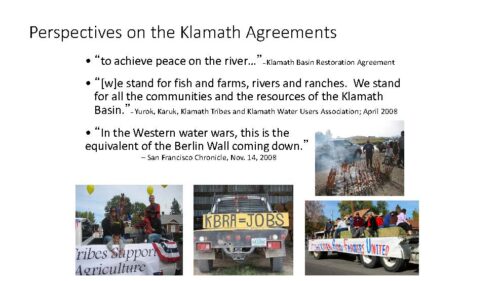 “Then, for the irrigators, there was certainty for the farmers, guaranteed flows, reductions during drought years, and a safe harbor agreement to avoid liability for salmon recovery after reintroduction. Also, there was a plan to retire irrigated ag on the off-project lands on a voluntary basis.”
“Then, for the irrigators, there was certainty for the farmers, guaranteed flows, reductions during drought years, and a safe harbor agreement to avoid liability for salmon recovery after reintroduction. Also, there was a plan to retire irrigated ag on the off-project lands on a voluntary basis.”
There were a lot of entities involved. People were excited about this; they saw it as a real sign of achieving peace on the river. The San Francisco Chronicle called it the equivalent of the Berlin Wall coming down.
Dr. Gosnell focused her research on understanding how the KBRA exemplified adaptive governance. The slide shows an abbreviated list of what they found.
“There was crisis and chaos, and then there was self-organization emerging after 2001,” she said. “What happened in the aftermath of 2001 can really be thought of as a period of reorganization involving new leadership amongst key stakeholders, such as tribes, ranchers, and farmers, and also a period of really slow and steady trust building.”
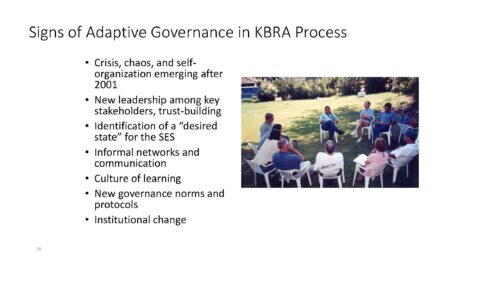 A desired state for the social-ecological system emerged as, over time, as they came together, they could see a future that they all agreed on that would be good for everybody.
A desired state for the social-ecological system emerged as, over time, as they came together, they could see a future that they all agreed on that would be good for everybody.
“That’s key for adaptive governance,” she said. “The identification of a desired state was really made possible by the FERC relicensing process, which happens every 50 years and just happened to coincide with the aftermath of 2001. So people had to come together to discuss dam removal, creating space to start having these important conversations.”
Out of the FERC process, there was the growth and strengthening of informal networks and much informal communication during negotiations of the KBRA. Also key was the culture of learning, as all the participants learned about the upper and lower basins and their impacts on others. As a result, they developed empathy for each other as well as a better understanding of the whole system and how it can be managed in a more holistic, integrated way.
“In many ways, it seemed that there was a double and triple loop learning going on,” said Dr. Gosnell. “There were shifting values as irrigators came to understand the Tribes’ point of view and vice versa. And there were also attempts to correct errors by designing new governance norms and protocols. So triple loop learning.”
The KBRA had a plan for institutional change by forming a Klamath Basin Coordinating Council that would have been comprised of the 28 key stakeholders for the entire basin in a formalized institution that would work together to figure out how to share water in times of shortage. It would have been an antidote to that upper basin-lower basin siloed fragmented approach to the management system.
“The key feature of adaptive governance is the capacity to respond to changing conditions, often under uncertainty,” said Dr. Gosnell. “The Klamath Basin Coordinating Council would have allowed for that possibility. They had also thought about the process, and there were plans for legitimacy; diverse actors would have had equal authority to participate. They had thought about equity, they had thought about conflict assessment, and resolution mechanisms. And this was all going to take place in the context of ongoing trust building and social learning opportunities.”
She acknowledged that it all sounds like Kum-ba-yah, but it was amazing. The governors of California and Oregon signed on and brought it to Congress, telling them it would solve many of their problems, but it would cost a billion dollars. And Congress decided not to fund it.
So where are they now? “The basin is really back in a state of disarray,” said Dr. Gosnell. “There have been many reflections on how things would have been better if there’d been a Klamath Basin Coordinating Council to help navigate the recent times of crisis and uncertainty in the last few years.”
“So the lesson here is that adaptive governance involves bottom-up and top-down dynamics, and without the formal institutionalization by the federal government, adaptive governance can really only go so far,” she continued. “There are remnants of the informal networks that were created, but there’s more animosity than ever due to ongoing drought and water shortages. In 2013, the Klamath Tribes’ water rights were quantified, which led to curtailment for many irrigators in the tributaries to Klamath lake. And then, of course, the ongoing Section 7 biological opinions that restrict water for the project farmers.”
Conclusions
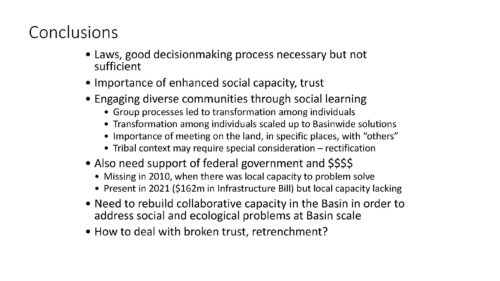 “As a result, we really concluded that the most pressing work to be done with regards to adaptive governance is to determine how to foster these conditions that allow the emergence of adaptive governance, but also, how to support some degree of institutionalization across the current range of approaches,” she said.
“As a result, we really concluded that the most pressing work to be done with regards to adaptive governance is to determine how to foster these conditions that allow the emergence of adaptive governance, but also, how to support some degree of institutionalization across the current range of approaches,” she said.
“Laws and good decision-making processes are necessary but not sufficient. It’s really important to have enhanced social capacity and trust, and it’s important to engage diverse communities through social learning. There are a lot of interesting processes that resulted in transformational learning amongst individuals and epiphanies and aha moments.”
“It’s important to meet on the land and at specific places with others. And the tribal context might require really special consideration of the need for rectification. Also, you need the support of the federal government for efforts like this.”
And money. “Interestingly, what was missing in 2010 when there was all this capacity at the local level to problem solve was the money. Well, now here we are in 2021. And the Biden administration is just throwing $162 million in the infrastructure bill at the Klamath Basin. But right now, there’s so little capacity that it’s really questionable how well they’ll be able to use that money. So right now, there’s a need to rebuild collaborative capacity in the basin to address social and ecological problems at a basin scale. You really need the governance mechanisms to match the scale of ecological problems.”
QUESTION: Moderator Chelsea Batavia asked if other panelists would like to respond right now to any of the presentations.
Dr. Ajami said she appreciated the reference to the culture of learning and the iterative nature of learning and adjusting. “We do a lot of data analysis in my team, and that’s what machine learning is. You keep taking in information, then readjust and rethink the process to find better answers. With machine learning, it’s faster and goes quickly; when humans are involved, it can get messy and complicated. But at the end of the day, what we are realizing in this century is the value of how you take knowledge and information, readjust and rethink whatever you’re doing, and make it better.”
Dr. Heikkila noted that it’s not just adapting our technical approach to how we manage social-ecological systems but that we’re using that information to help us understand values, the structure of the governance system, and more of the human and institutional processes that we have to learn about. “Sometimes, it’s even harder to learn about those elements of the system. … Still, at the end of the day, when that learning occurs, it’s necessary, but it’s not sufficient to build a long-term robust adaptive governance system. These systems are fragile, and if we don’t have that kind of activity across scales of governance as well, it’s difficult to operate adaptive governance in isolation or one scale of decision-making or with certain actors that have authority but not all of the actors. So it’s a challenge.”
QUESTION: Are there concrete examples of specific processes, institutions, or governance mechanisms that support adaptive management?
Dr. Heikkila referred to a survey by Dr. Mark Lubell that found a positive perception of some elements of the capacity for adaptive management in the Delta. “I think that is because it’s infused into the institutional design of the Delta Plan. In the structures and institutions that govern the Delta, it’s something that we recognize is a priority. But we also found in that survey that those perceptions of efficacy are higher amongst people involved in venues that have better leadership, trust, and engagement. So it’s not necessarily an issue of resources in the Delta but an issue of those kinds of social learning mechanisms. … But I would just emphasize that those social dynamics have to be infused into the adaptive governance structures that enable more effective adaptive management. So it’s not that adaptive management can’t occur without this supportive framework of adaptive governance, but they really do intertwine. And I would say those kinds of social and process-based principles are essential, from what I’ve seen in the Delta.”
Dr. Ajami pointed out that transparency and trust also play an important role. “Transparency is very much related to better information and trust in the system. … I think when you have better data and information, that can sometimes create more transparency, more trust across the board, and bring more people together to collaboratively manage something.”
She pointed out that many different decision-makers are impacted by decisions made in the Delta, but they are disconnected from the Delta because it doesn’t inform their day-to-day management decisions. “However, every single one of those decisions can have a ripple effect on how the health and well-being of the Delta are measured. So when there is no transparency or information that informs a process, it’s very difficult for people to understand how and where they get into this process and how they can have a feedback loop into the process.”
QUESTION: Resilience is one of the desirable outcomes associated with adaptive governance. What governance arrangements or processes are needed to facilitate adaptation and promote the Delta’s long-term resilience?
Ms. Lai Ross reminded that big issues such as transportation planning and housing already occur at a regional level, and that’s the direction she thinks we should be heading. “The idea of regionalism and planning on a regional basis is not new by any means. But there is no regional entity, with that authority, with a dedicated stream of funding in the Delta to implement climate adaptation.”
For example, the federal government designates Metropolitan Planning Organizations throughout the state that are required to maintain regional transportation plans and sustainable community strategies. They are required to work with local governments to ensure they have input and that the local and regional plans are consistent so that future transportation improvements consistent with that plan are eligible for federal funding.
“I’m suggesting some type of regional governance structure similar to this for adaptation because, under this structure, local and regional coordination is required,” she continued. “So we hope that Delta Adapts will become the long-term vision and plan for adaptation for the Delta. We’re working with various stakeholders to develop this plan, including the cities and counties, vulnerable communities, tribal communities, and many others. But we don’t have the funding or the authority to implement it; we’re really relying on many other entities at various levels to implement adaptation.”
“Now, I want to be clear, I’m not suggesting the council should be that entity,” emphasized Ms. Lai Ross. “There are many other regional collaboratives in place now, and those authorities can be expanded. Another option is the role of the MPOs could be expanded to include adaptation; it would require a change in legislation, but the underlying framework and structure are already in place. So those are just some ideas. I think a regional entity with dedicated funding would help build long-term resilience in the Delta.”
Dr. Ajami pointed out that money is key in this process. “Unless you provide resources to pay for some of these solutions to be implemented, we cannot move forward because this requires resources and money. And the second thing is shifting your thinking. Objectives and goals are very important, but remember, a lot of goals and objectives and laws that we have in place are set for whatever understanding we had of the system in the past few centuries. Now, we are in a totally different area, with totally different challenges and totally different opportunities. And unfortunately, our regulatory system is not designed to make massive shifts, which is actually, in some cases, not a bad thing, because you want to change gradually to ensure you don’t make a huge mistake in this process. But that adaptive governance and adaptive change can enable us to gradually move this massive ship towards the new goals and objectives that we have in place. And I think those regional authorities, if they really do have the resources and clear objectives and goals, can potentially enable some of this shift and change to happen. But definitely having fees and money is key in this process.”
QUESTION: What is the relationship between adaptive governance and equity? And how can that relationship be designed or strengthened so that the overall system governance, flexibility, responsiveness, and equity can be mutually enforcing with one another?
“Our laws, policies, and institutions, reflect our values,” said Dr. Heikkila. “If we want an adaptive governance system, we need to be adaptive to new values. We can’t be rigid within the old values we had in those laws, policies, and institutional structures. So equity in adaptive governance is about giving people equal opportunities in the processes. So there’s equity in the process for some of those new values that are coming into play in our social and ecological systems to really have a voice in how we will govern for the future.”
But simply including diverse voices in governance processes just to inform decision-making isn’t enough, she said. “You need to also pay attention to who has power and authority. And that plays an important role in equity, as well. When you start bringing in new voices and giving them more power and authority in decision-making, that can threaten existing interests. So it really needs to be clear how such changes in the governance system to bring more equity and voice can be beneficial, and normatively, just the right thing to do.”
In the Klamath Hydroelectric Settlement Agreement, Dr. Gosnell said a key factor in the success at the local and state level was that it explicitly dealt with the need to rectify past wrongs against indigenous peoples in both the upper and lower basins. “The dams coming out would have addressed the salmon decline in the lower basin. The dams still are going to come out, so the KHSA did go forward; the Klamath Basin Restoration Agreement (KBRA) did not. The tribes would have gotten land back as part of the KBRA … there was going to be money for restoration for the fish that were important to tribes, and also money for economic development in general. So social restoration, as well as ecological restoration. As former Tribal chairman Alan Forman once said, there’s rectification that has to be done. And without that, this basin is not going to move forward.”
“The KBRA focused on social as well as ecological restoration as a holistic, integrated approach,” she continued. “The KBRA didn’t get funded, but the tribes have had their rights quantified, and their rights go back to time immemorial. The quantified rights are basically that they control most of the water in the river basin. And they’re like not interested in collaborating anymore. And so, it just goes to show that with the rise in tribal sovereignty all around the world, as tribes gain more legal power, if not political power, it’s going to be more and more important to figure out how we can rectify past wrongs because without that, you’re not going to be able to get stuff done.”
Ms. Lai Ross pointed out that the Delta Adapts project was the first initiative at the Council where big strides were made in addressing equity. “We made a concerted effort in the very beginning to forge those relationships with various community-based organizations and service providers to understand what vulnerable communities need and really to gather input into our process.”
These efforts included holding three workshops in vulnerable communities, forming an environmental justice expert group that met regularly to advise their work, and expanding their efforts to talk more with Tribes, homeless folks, and farmworker communities. “It’s really about engaging those sectors that normally don’t participate in planning processes and really getting them to engage so that we can have a more equitable and a better adaptation plan.”
Dr. Ajami reemphasized the earlier point that just because people are at the table expressing their opinion doesn’t mean they are impacting the process. “The process is derived by objectives and goals. And if those objectives and goals do not reflect the broader, diverse group of people’s needs and requirements, it would not necessarily lead to the outcome we are thinking about. So it’s important to create real space.”
For example, in a regulatory process, there may be community members interested in the project who want to express their opinion, so they just come and express their like or dislike of the project. “But that doesn’t necessarily change that outcome because they don’t necessarily have the technical capacity, and their requirements are not part of that performance measure process that we are requiring out of these systems,” said Dr. Ajami. “So in addition to creating these shared goals and objectives, we need to make sure our institutions are also diverse so that it has people that can think about these things and provide feedback on how we need to adjust ourselves to ensure we are meeting 21st-century challenges. If it’s not that way, it’s very difficult to use the same model we have had with the same bodies, the same thinking, and the same technical capacity, and expect a different outcome just because we say we care about equity and justice.”
QUESTION: In the Delta, the governance system is closely intertwined with precisely engineered physical infrastructure and groundwater management. Could you reflect on the implications of the engineered system a little bit more? And specifically, to what extent or how do these water operations and water delivery systems create rigidity? And what sorts of changes in governance do you think are needed to meaningfully enhance the adaptive flexibility and responsiveness of the governance system?
Dr. Ajami said that water management is the confluence of two things: Because of climate change, our water systems are dealing with significant and unprecedented uncertainty in how much water they have and how they should manage it to make sure they meet the reliability that’s required of them. On top of that, the ecosystem is falling apart due to climate change and rigid management rules.
“For example, many water utilities do care about ecosystem health, but that is not their calling,” she said. “Their calling is to make sure the water comes out of the tap when people open their tap, and it’s clean and accessible. And so it makes it very, very difficult to kind of have these co-benefits work together or coexist at the same time when you’re calling is not that.”
Dr. Ajami also pointed out that a lot of water management is driven by water rights systems, and if the water rights system is not reflecting the health of the ecosystem, it makes it very difficult. “Remember, when we built this system, we left people and the ecosystem out. And by people, I meant not just people with diverse voices, but also people like you and me who depend on these water systems. The average person might care about water coming out of the tap. But, they’re not thinking about how they wasted all the water, so salmon doesn’t have water. That’s not what they’re thinking. They’re not connecting the dots, really. So educating people is key because then these utilities can actually change their behavior in a way that reflects our environmental goals and objectives and meets water reliability.”
QUESTION: What’s the role of shared data systems and adaptive governance? Are there examples of regional authorities or other networks of actors and shared values but differing authority where data sharing systems support more collaborative and effective decision-making, and are there barriers to implementing these?
“Shared data and tools can provide some baseline we can work off of,” said Dr. Ajami. “Right now, we don’t even have shared data or shared models that we all agree on. And it’s very difficult when people use different data sets and models to give different answers. It’s very difficult to create cooperation and collaboration across the board when you don’t have a baseline to work from.”
Dr. Heikkila pointed out that data is a function of the different regulatory requirements that trigger the type of monitoring done in systems like the Delta. “Each agency has its own monitoring requirements and regulatory mandates that they have to meet that drive that type of data collection, and that, in effect, creates some of the mismatches in terms of the type of data being collected, the scale at which that data is collected, and the timeframe of the data. So, the coordination and sharing of the data is a serious challenge, but it raises a really good point that can help provide some shared baseline knowledge if we can think in more creative ways about how to create a learning system. One of the resources in our learning system is having shared knowledge and shared understanding of what those systems dynamics are.”
“We need more conversations around where we can align some of the datasets that we have, which is something that the Delta Independent Science Board has recommended in its monitoring review. The review identified the need for a more institutionalized approach to coordinating monitoring across the Delta.”
Dr. Gosnell noted that in her research, one of the key components was the collaborative hydrological modeling effort led by the Klamath tribes, which involved Fish Wildlife Service, NMFS, the Bureau, and key stakeholders. “It was one of the barriers to people getting on the same page about how to manage the system as a whole … So Fish and Wildlife Service hired a hydrologist specifically to be involved in these negotiations so that they could speak the same language with the Bureau and some of the other stakeholders. That was considered to be a key move. Just getting together and learning how the whole system works – that social and technical learning opportunity created the space for them to figure out how to create a joint biological opinion that deals with the upper basin and lower basin together instead of the separate approach … if you don’t have people who speak the same language, the same kinds of scientists representing the different agencies, you’re going to have real communication barriers.”
QUESTION: Region is a slippery concept; it requires making boundaries and choices and qualities that are used to draw them – geography, governance, values, etc. There are issues of scale and equity about where the edges are drawn. What are your thoughts on how a region can be accurately defined?
Ms. Lai Ross acknowledged that a regional entity for adaptation is not the perfect answer; it has downsides. “There is the push and pull of local control, but the idea is that any form of addressing anything regionally means that there have to be active partners, and all partners have to be involved and have to have a stake in whatever the group comes up with and input into the process of what gets adopted. And that includes what the region how the region is defined. … It’s not the perfect answer. But, conceptually, if you do it together, all the partners, whether there is a regional entity with teeth or not, you have to work together with everyone in that region. So conceptually, then everyone gets something out of it. It’s not the perfect answer, but it is a potential solution.”


